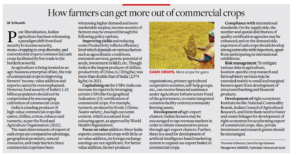Topics
- The Earth’s climate is getting too close to a hot tipping point. (Livemint)
- Nuances of Indian Foreign Policy (The Statesman)
- Incentivising Mineral Exploration. (Financial Express)
- Glaring lapses. (Millenium Post)
- Building an inclusive social safety system (Hindustan Times)
- How farmers can get more out of commercial crops. (Business Line)
- Why Cheetahs are Dying in India. (Hans India )
Topic 1: The Earth’s climate is getting too close to a hot tipping point.

GS 3: Envionment
Context:
- The author discusses the recent extreme weather events, such as floods, fires, and heatwaves, and examines whether they indicate that the planet has reached a climate tipping point.
- Climate scientists and ecologists have long warned about tipping points, which occur when small changes lead to significant outcomes.
- The risk of a global tipping point triggering accelerated climate warming becomes significant when average worldwide temperatures rise 1.5° Celsius above pre-industrial levels, likely to happen in the 2030s.
Understanding Tipping Points:
- Tipping points refer to shifts in feedback loops, where stabilizing feedback loops are disrupted, and new ones amplify change.
- Scientists have identified regional and local climate tipping points throughout Earth’s history, leading to significant shifts in climate and mass extinction events.
Concerns and Tipping Elements:
- Researchers are now worried about regional changes that could escalate into global catastrophes.
- Tipping elements, such as glaciers, forests, and coral reefs, pose immediate threats.
- Notable examples include the destruction of the West Antarctic and Greenland ice sheets, thawing permafrost, and loss of coral reefs.
The Role of Extreme Events:
- Extreme events observed in recent times might represent flickering—a brief visit to the other side of a tipping point.
- While it is uncertain whether these events will lead to a permanent shift, the possibility of a tipping point is a cause for concern.
Ecosystem Collapse and Human Impact:
- The Sahara Desert’s transformation from lush to dry cycles serves as an example of past ecological tipping points, possibly influenced by human activities.
- Recent research indicates that ecological tipping points can occur rapidly when multiple stresses, like overgrazing, deforestation, and overfishing, are considered.
The Amazon and Civilization’s Vulnerability:
- Deforestation in the Amazon could trigger a vicious cycle, leading to a drier and warmer climate, accelerating forest loss, and releasing more carbon into the atmosphere.
- The author emphasizes that our civilization, heavily reliant on agriculture and clean water, is delicate and vulnerable to the impacts of climate tipping points.
Conclusion:
While humanity has survived previous climate shifts, the possibility of a climate tipping point poses significant challenges to our way of life.
Although we have not yet reached the edge, the repeated and haste emphasizes on the importance of addressing climate change to avoid potential catastrophic consequences can have significant impacts.
Topic 2: Nuances of Indian Foreign Policy

GS 2: International Relations
Context:
- The recent Shanghai Cooperation Organisation (SCO) summit hosted by India and the upswing in its relationship with the United States highlight India’s strategic approach to navigate complex geopolitics without getting caught in the US-China neo-Cold War dynamics.
- India’s active participation in various multilateral organizations, coupled with its engagement with bilateral partners, showcases its commitment to strategic autonomy and an independent foreign policy.
India’s Engagement in Multilateral Organizations:
- India is a prominent member of various multilateral organizations, including BRICS, ASEAN, IORA, SAARC, and BIMSTEC.
- It champions the cause of Africa and has proposed the inclusion of the African Union as a G20 member.
- India is also part of the Quadrilateral Security Dialogue (QUAD) and the Indo-Pacific Economic Forum, maintaining a careful balance between addressing concerns regarding China and preserving its historic relationships with other states.
India’s Stance on International Issues:
- India has historically opposed bloc politics and advocated for a multipolar world.
- It actively engages in multilateral forums to voice its concerns on climate change, multilateral economic order, cyber security, and technological innovations.
- While it maintains relations with countries like Russia and Iran, it does not conform to Western sanctions, as these relationships are vital to its security challenges and historical ties.
Strategic Autonomy and Diversification:
- India seeks strategic autonomy in its foreign policy and is open to diverse energy procurement options.
- It signed a tripartite agreement with Iran and Afghanistan on Chahbahar port and received the S400 missile system from Russia despite potential US sanctions.
- India’s diversification efforts extend to seeking advanced technology and weapons from the West while also pursuing joint production agreements.
Balancing Contending Powers:
- India carefully balances its engagement with contending powers like China and Russia.
- While it engages in dialogue with China and avoids open criticism, it remains firm on its defense cooperation with Russia.
- India also watches the growing Russia-China relationship closely, considering the implications for its security.
Multilateralism and Minilateralism:
- India’s foreign policy combines multilateralism and minilateralism.
- Multilateral organizations like BRICS and SCO offer opportunities for specific cooperation among like-minded countries, while minilateral forums allow India to pursue its interests effectively in the changing world order.
Strategic Autonomy through Multilateral Organizations:
- India’s strategic autonomy is closely linked to its participation in various multilateral organizations.
- It allows India to navigate geopolitical and geoeconomic challenges, climate change issues, and maritime disruptions effectively.
- As an emerging power, India engages all countries, including those with which it has border conflicts, and adheres to its independent stance on China and Russia, rather than following the West’s perspective.
Conclusion:
India’s commitment to strategic multilateralism remains paramount in a world marked by shifting geopolitical dynamics and intensifying competitions.
As it continues to navigate complex geopolitical issues, India uses multilateral and minilateral forums to advance its foreign policy objectives and exercise strategic autonomy, fostering a significant role in shaping global politics while maintaining its historical relationships and non-aligned principles.
Questions
- How has India’s evolving approach towards international trade and economic integration impacted its foreign policy decisions, particularly in the context of global economic power shifts?
Topic 3: Incentivising Mineral Exploration

GS 3
Challenges in India’s Mining Sector:
- India’s mining sector faces obstacles to sustainable growth, primarily due to the lack of adequate mineral exploration.
- As a result, India remains import-dependent for critical minerals required in the manufacturing of green technologies like wind turbines, solar panels, batteries, and electric vehicles.
Identifying Critical Minerals:
- The Ministry of Mines in India has recognized 30 critical minerals essential for various sectors’ growth in the country.
- These minerals play a crucial role in achieving India’s long-term goal of reaching net-zero emissions by 2070.
Historical Approaches to Mineral Exploration:
- In the early 1990s, India’s economic liberalization and the National Mineral Policy of 1993 attracted private investment from leading global exploration companies such as De Beers, Rio Tinto, and Anglo American Group.
- Private companies could apply for prospecting and reconnaissance exploration permits under the First Come First Serve (FCFS) system.
Challenges with FCFS and Transition to Auctions:
- The FCFS system faced criticism for potential manipulation and misuse, leading to the Supreme Court of India ruling against it in 2012.
- Subsequently, the Mines and Minerals (Development and Regulation) Act, 1957, was amended in 2015, replacing the FCFS method with auctions.
- However, this change resulted in a decline in exploration activities and reduced interest from private exploration companies.
National Mineral Exploration Trust (NMET) and its Limitations:
- Established in 2015, the NMET aimed to incentivize investment in exploration by public and private entities.
- However, private exploration agencies have shown limited interest in utilizing NMET funds, with 90% of projects allocated to the Geological Survey of India (GSI).
Proposed Exploration Licences (ELs):
- To encourage exploration of deep-seated and critical minerals, the Ministry of Mines proposed the introduction of Exploration Licences (ELs) through auctioning.
- Eligible explorers would bid on a percentage share of the auction premium payable by a Mining Leaseholder to the state upon a successful discovery and subsequent auction.
- EL holders would only receive revenue after operationalizing a discovered mine.
Recommendations for Encouraging Private Exploration:
- To further incentivize private exploration, the existing Composite Licence (CL) regime can be adapted.
- For greenfield blocks without knowledge of mineral presence, eligible parties should bid on the value of minerals payable to the state upon discovery.
- The CL’s scope should expand to allow reconnaissance for a greater maximum area, and leaseholders should provide periodic reports on work progress.
- After three years of reconnaissance, the leaseholder should relinquish 75% of the original area.
Driving Self-Sufficiency and Green Transition:
- Implementing these recommendations would address the government’s concerns about granting mineral concessions solely through auctions while also empowering exploration companies with the right to mine their discovered resources.
- Developing a globally competitive exploration industry would enable India to achieve self-sufficiency in raw materials and support its green transition initiatives.
Conclusion
Adopting these measures would help India overcome challenges in its mining sector, stimulate private investment in mineral exploration, and support the country’s long-term goals of sustainability and green technology adoption.
Topic 4: Glaring lapses
![]()
GS 3: Environment
Context:
Urban misgovernance, illegal encroachments, and fast-depleting urban water bodies are the root causes behind the massive deluge faced by major Indian cities
Introduction:
- The increasing frequency and severity of urban flooding in major Indian cities, including the national capital Delhi, have raised concerns about the state of their drainage systems.
- While climate change has brought about unpredictable weather patterns, the inadequacy of drainage infrastructure and poor urban governance exacerbates the problem.
- The root causes include illegal encroachments, outdated drainage systems, disappearing wetlands, and improper waste disposal.
Unprepared Drainage System and Climate Change:
- Cities face heavy rainfall concentrated within short periods due to climate change.
- While the rainfall has been exceptionally heavy and breaking records, the lack of preparedness and proactive measures in drainage systems is unacceptable.
Causes of Urban Flooding:
- Several factors contribute to urban flooding, including illegal encroachments, inadequate stormwater drainage capacity, the disappearance of urban wetlands, and solid waste clogging the drains.
Neglect of Stormwater Drainage:
- Stormwater drainage is an essential part of urban infrastructure, but it often receives insufficient attention from urban governments.
- Many cities have outdated drains incapable of handling increased rainfall intensity.
Lack of Drainage Maps:
- A concerning fact is that many cities lack proper drainage maps, hindering effective urban planning and flood management.
Ineffective Drain Cleaning Efforts:
- Despite issuing cleaning instructions before the monsoon, poor supervision and corruption often result in ineffective desilting efforts, allowing garbage and silt to clog drains.
Disappearance of Urban Wetlands:
Cities have lost significant urban wetlands, which once served as natural drainage systems, further disrupting water flow and regulation.
Solutions and Challenges:
- Upgrading stormwater drains and restoring urban wetlands are essential solutions, but strong political will and sufficient funds are required.
- Proper urban governance, empowered local bodies, and effective use of technology are crucial for tackling the drainage crisis.
Examples of Successful Initiatives:
Some cities, like Kuala Lumpur and certain regions in China, have implemented successful drainage projects to protect against flash floods and capture stormwater runoff.
Addressing Urban Governance:
- Urban governance reforms are vital for solving drainage, sewerage, and waste management issues.
- Empowering local representatives, building their capacities, and developing competent technical personnel are necessary steps.
Devolution of Funds and Functions:
Transferring funds, functions, and functionaries to local bodies is crucial for ensuring accountability and generating resources for city development.
Conclusion:
To transform Indian cities into engines of growth with a high quality of life, addressing urban flooding and drainage issues requires a holistic approach.
Combining effective urban governance, technical expertise, sufficient funds, and technology can lead to better flood management and sustainable urban development.
Topic 5: Building an inclusive social safety system

GS 1,2,3
Context:
- The International Labour Organization (ILO) defines social protection as a range of benefits, including maternity, unemployment, health, and old-age protections, among others.
- Governments worldwide offer various models of social protection, with funding sources varying between organized and unorganized sectors.
Current Social Protection Coverage:
- Globally, only 46.9% of the population receives benefits from at least one social protection program.
- In India, the coverage is relatively limited, with only 24.4% of the population benefiting from at least one program due to definitional and measurement issues.
Definitional Issue:
To be considered part of social protection, a scheme must be statutory, offer regular cash benefits, and be distributed through bank accounts, thereby excluding measures provided in kind.
Measurement Issue:
- India’s large unorganized sector, comprising about 80% of the workforce, poses challenges in identifying unique beneficiaries and making benefits easily accessible.
- This leads to an undercounting of efforts and expenditures made in the country’s social protection initiatives.
Limited Representation in Global Reports:
- The World Social Protection Report (WSPR) by ILO only considered seven schemes aligned with sustainable development goal national indicators, thereby overlooking over 100 social protection schemes implemented by 25 ministries and departments in India.
eShram Database:
eShram, the largest global database of about 290 million unorganized workers in 475 occupations, was utilized to match social protection schemes data and identify beneficiaries to improve scheme delivery.
Expanding Mapping Efforts:
- To enhance accuracy, the government is mapping nearly 60-plus schemes within the ambit of WSPR.
- This mapping exercise will provide vital information for effective policymaking and enable the optimization of social protection schemes.
Collaborative Effort:
- The ministry engaged with ILO to share comprehensive data, ensuring a more accurate assessment of social protection coverage and impact in India.
- The next step is resolving the issue of recognizing social security provided in kind.
Conclusion:
The collaborative effort between the ministry and ILO signifies a commitment to achieving a more comprehensive, accurate, and representative global understanding of social protection, particularly in countries with large informal sectors, such as India.
Expanding the definition of social security in global reports will further improve social protection coverage worldwide.
Topic 6: How farmers can get more out of commercial crops.
![]()
GS 3: Agriculture

Topic 7: Why Cheetahs are Dying in India
![]()
GS 3 : Conservation
Context:
- Distinguished wildlife biologist A.J.T. Johnsingh and other conservationists cautioned against the relocation of African cheetahs in India due to unsuitable habitat.
- India’s past over-hunting and habitat loss led to the extinction of cheetahs in the country.
Unsuitable Habitat:
- Lack of prey species and adequate space for cheetahs to thrive in India.
- Kuno, the site of the recent reintroduction, has hilly terrain, dense forests, and high temperatures unsuitable for cheetah survival.
- Cheetahs could be killed by wild dogs, lions, and tigers.
Insufficient Preparations:
- The reintroduction plan did not consider critical factors for preserving the species.
- Lack of understanding of cheetahs’ needs and behaviors.
- Cheetahs cannot be easily domesticated and need freedom to move.
Human Population Pressure:
- India’s densely populated landscape creates conflicts with wildlife conservation efforts.
- Historical human pressure led to the extinction of cheetahs in India, and the situation has worsened over time.
Political Agenda:
- The reintroduction project is seen as a pet project to please political bosses, disregarding conservation concerns.
- The idea of reintroducing cheetahs’ dates back to the 1950s, with recent revival in 2009.
Conclusion:
- The experiment of reintroducing African cheetahs in India has led to their tragic demise without resorting to bullets.
Insufficient consideration of habitat, prey availability, and human population pressure contributed to the failure of the project.

